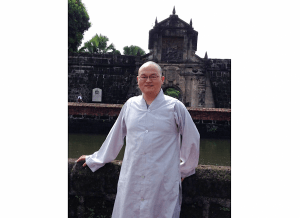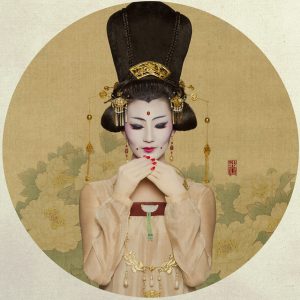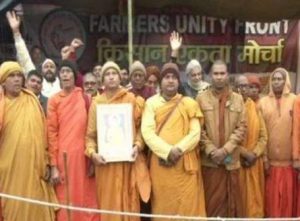
Laura Lettere is a 2020 Postdoctoral Fellow in The Robert H. N. Ho Family Foundation Program in Buddhist Studies at the University of Naples “L’Orientale.” It is the only tertiary institute in Italy to host a Centre for Buddhist Studies and remains the oldest school—and among the most prestigious—of sinology and Asian studies in Europe. Dr. Lettere studied Chinese philology and Sanskrit at La Sapienza University for her BA. After her MA she studied Chinese in Beijing and became a licensed teacher in Mandarin Chinese after her return to Italy. She earned her PhD in 2018.
She is in the midst of completing a monograph on the Chinese translation of the Buddhacarita (T192). By means of both an accurate philological reading and computer-based analysis, her work will explain the peculiarities of T192 as a translation and explain its interrelation with earlier Chinese translations of Buddhist texts. Through an analysis of T192’s relationship with the Tibetan translation, Dr. Lettere aims to clarify whether chapters 15–28 of the Chinese account are actual translations of a lost Sanskrit source or were composed in China and based on earlier Chinese translations or Central Asian sources. A preliminary study of the last 14 chapters of the Tibetan version of the Buddhacarita will be a byproduct of this research.
Buddhistdoor Global: Your study blends philosophy with narrative and even cross-cultural translation. A critical theme is how a quintessentially Indian debate on cosmogony—with therefore Indic presuppositions and worldview—was introduced in China as early as the beginning of the fifth century. This would have been of immense significance to thinkers, the Buddhist community in China, and political players such as the emperor. Do you have any thoughts about the general significance of what you’ve found so far?
Laura Lettere: The debate on cosmogony I introduced in my lecture is present in two texts, being the translation of Aśvaghoṣa’s Buddhacarita, known in China as Fó suǒxíng zàn; 佛所行讚 (T192), translated by Bǎoyún (寶雲) and in the T1568 Shíèr mén lùn (十二門論; *Dvādaśanikāya-śāstra) attributed to Nāgārjuna, translated by Kumārajīva. So we have two texts proposing a similar theme—the refutation of Īśvara as a creator or a divine principle generating the world—translated in different contexts in the same period (the early fifth century CE).
At this early stage of my research, I can say that these attestations of a debate on cosmogony are probably the earliest in the Chinese canon and, quite interestingly, are also very early examples of refutations of Īśvara—the name for a supreme being like a Godhead—in the Indian context. I am very glad that I was given the opportunity to present this research at the Conversations on Chinese Philosophy online symposium in April—jointly held by the Centre for East Asian Studies of L’Orientale and the Institute of Humanities of Tallinn Univeristy—so that I could have an exchange on this topic with other sinologists and buddhologists.
I need to mention that I am deeply influenced by the work of Prof. Stefano Zacchetti, who underlined the importance of the relationship between the Xuánxué debates and the spreading of Buddhism in cultured circle in medieval China. Of course, I had the suspicion that the arguments against Īśvara may have found fertile ground in a possible confrontation with the Daoist cosmology.
I am glad that during the Q&A session, Prof. Friederike Assandri mentioned the Fódào lùnhéng (佛道論衡), where we can read a description of a debate on cosmogony between a Daoist master and a Buddhist master. This confrontation happens in the presence of the Emperor Gaozong of the Tang dynasty. I will work following these two research paths in order to ascertain the possible influence of the Indian debate on cosmogony on the Chinese philosophical debate.
BDG: Your present project will focus on the introduction of new philosophical ideas through narrative. Was this a cultural innovation of its time in ancient India? Does it reflect trends in philosophical or prose discourse in competing religious traditions?
LL: The transmission of philosophical debate through narrative, as represented in the Buddhacarita, is not a cultural innovation per se, as Indian epic narratives were also very engaged in religious and philosophical debates. In my opinion, the innovative aspect in the Buddhacarita—at least in the first 14 chapters—is the emphasis on the dramatic aspect of the dialogue. As various scholars have pointed out, the Buddhacarita can be read as a play, and in fact Aśvaghoṣa is also known as a playwright.
BDG: The Buddhacarita lays out a narrative format of Brahmanical perspectives, which are correspondingly refuted by a Buddhist response. Is there any sense in Chinese translations of the text that the Chinese recipients of the Buddhacarita sensed a philosophical battle between Buddhism and Brahmanism?
LL: The translators of the Buddhacarita, I mean here Bǎoyún, probably helped by the meditation master Buddhabhadra, had a clear idea that a philosophical debate was indeed taking place between Buddhism and Brahmins. Nevertheless, it is interesting to note that the translators omitted all the references to rituals performed by Brahmins for the king. They probably did not want to emphasize the presence of a “competing” tradition.
BDG: How specifically did the Buddhacarita influence Chinese Buddhism after it was introduced into China?
LL: Actually, several scholars have tried to assess the influence of the Buddhacarita not only on Chinese Buddhism, but also on court literature in the southern dynasties. In this respect, I want to mention a 1991 article by Prof. Wang Chunhong from Lingnan University, which explains how the introduction of similes involving the senses of smell and taste in court poetry can be connected to the translation of the work of Aśvaghoṣa in Chinese. As for the influence on Chinese Buddhism, the Buddhacarita, which is a very long and detailed account of the life of the Buddha, was later adapted as the text now called the Scripture on past and present causes and effects (過去現在因果經, T.189), a text that became very influential in Chinese wall paintings and Japanese scroll paintings.
The second part of the Chinese Buddhacarita (chapters 14–28) proved to be very influential and is quoted in a wide variety of texts from the same period. I think that mapping these connections will prove very useful in explaining the relationship between texts that were probably unrelated in their original context, becoming then very close in China, where they happened to be translated by the same translation teams.
BDG: What are the next stages of your project?
LL: Thanks to the generous support of The Robert H. N. Ho Family Foundation Program in Buddhist Studies, I am working to rewrite part of my PhD dissertation and to publish it as a monograph. I hope to integrate in my previous work information derived from the chapters 14–28 of the poem, today available only in Chinese and Tibetan translations. It is both a difficult and rewarding task. The Buddhacarita is indeed an example of a literary classic: every re-reading of the poem can provide new interpretations.
Moreover, investigating the difficulties of translating such a masterpiece in Chinese in pre-modern times, the identity of its translators, and the complex network of connections between texts translated in the same era can give us new tools in understanding the role of translators and the multifold influence their works exerted in pre-modern times.
See more
Laura Lettere F’20 (ACLS)
Related features from Buddhistdoor Global
Echoes of Indian Buddhist Culture in China: An Interview with Prof. Shashi Bala, Part One
Early Transmission of Sanskrit Buddhist Texts in China: An Interview with Prof. Shashi Bala, Part Two












